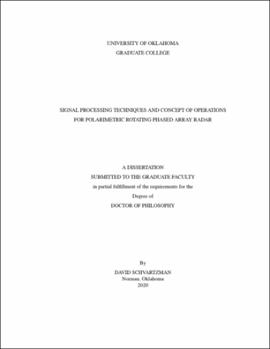| dc.contributor.advisor | Yu, Tian-You | |
| dc.contributor.author | Schvartzman, David | |
| dc.date.accessioned | 2020-12-04T21:22:23Z | |
| dc.date.available | 2020-12-04T21:22:23Z | |
| dc.date.issued | 2020-12-18 | |
| dc.identifier.uri | https://hdl.handle.net/11244/326580 | |
| dc.description.abstract | The Weather Surveillance Radar 1988 Doppler (WSR-88D) network has been operational for over 30 years and is still the primary observational instrument employed by the National Weather Service (NWS) forecasters to support their critical mission of issuing severe weather warnings and forecasts in the United States. Nevertheless, the WSR-88Ds have exceeded their engineering design lifespan and are projected to reach the end of operational lifetime by 2040. Technological limitations may prevent the WSR-88D to meet demanding functional requirements for future observational needs. The National Oceanic and Atmospheric Administration (NOAA) has started considering radar systems with advanced capabilities for the eventual replacement of the WSR-88D. Unique and flexible capabilities offered by Phased Array Radar (PAR) technology support the required enhanced weather surveillance strategies that are envisioned to improve the weather radar products, making PAR technology an attractive candidate for the next generation of weather radars. If PAR technology is to replace the operational WSR-88D, important decisions must be made regarding the architecture that will be needed to meet the functional requirements. A four-faced planar PAR (4F-PAR) is expected to achieve the requirements set forth by NOAA and the NWS, but deploying and maintaining an operational network of these radars across the U.S. will likely be unaffordable. A more affordable alternative radar system is based on a single-face Rotating PAR (RPAR) architecture, which is capable of exceeding the functionality provided by the WSR-88D network. This dissertation is focused on exploring advanced RPAR scanning techniques in support of meeting future radar functional requirements. A survey of unique RPAR capabilities is conducted to determine which ones could be exploited under an RPAR Concept of Operations (CONOPS). Three capabilities are selected for further investigation: beam agility, digital beamforming, and dwell flexibility. The RPARs beam agility is exploited to minimize the beam smearing that results from the rotation of the antenna system over the collection of samples in the coherent processing interval. The use of digital beamforming is investigated as a possible way to reduce the scan time and/or the variance of estimates. The RPAR's dwell flexibility capability is explored as a possible way to tailor the scan to meteorological observations with the goal of improving data quality. Three advanced RPAR scanning techniques are developed exploiting these capabilities, and their performance in support of meeting the radar functional requirements is quantified. The proposed techniques are implemented on the Advanced Technology Demonstrator (ATD), a dual-polarization RPAR system at the National Severe Storms Laboratory (NSSL) in Norman, OK. Data collection experiments are conducted with the ATD to demonstrate the performance of the proposed techniques for dual-polarization observations. Results are verified by quantitatively comparing fields of radar-variable estimates produced using the proposed RPAR techniques with those produced by a well-known collocated WSR-88D radar simultaneously collecting data following an operational Volume Coverage Pattern (VCP). The techniques introduced are integrated to operate simultaneously, and used to design an RPAR CONOPS that can complete a full volume scan in about one minute, while achieving other demanding functional requirements. It is expected that the findings in this dissertation will provide valuable information that can support the design of the future U.S. weather surveillance radar network. | en_US |
| dc.language | en_US | en_US |
| dc.rights | Attribution 4.0 International | * |
| dc.rights.uri | https://creativecommons.org/licenses/by/4.0/ | * |
| dc.subject | Weather Radar | en_US |
| dc.subject | Polarimetric Phased Array Radar | en_US |
| dc.subject | Signal Processing | en_US |
| dc.subject | Concept of Operations | en_US |
| dc.subject | Digital Beamdorming | en_US |
| dc.title | Signal Processing Techniques and Concept of Operations for Polarimetric Rotating Phased Array Radar | en_US |
| dc.contributor.committeeMember | Torres, Sebastian | |
| dc.contributor.committeeMember | Yeary, Mark | |
| dc.contributor.committeeMember | Salazar-Cerreno, Jorge | |
| dc.contributor.committeeMember | Wang, Ying | |
| dc.date.manuscript | 2020-11-02 | |
| dc.thesis.degree | Ph.D. | en_US |
| ou.group | Gallogly College of Engineering::School of Electrical and Computer Engineering | en_US |
| shareok.orcid | 0000-0002-7490-4809 | en_US |

